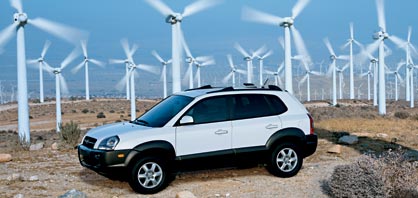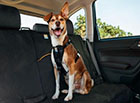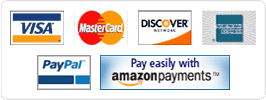|
|
2005 - 2009 Hyundai Tucson Information PageClick here to go back to our 2005 - 2009 Tucson accessories Tucson Boasts Even Better Fuel Economy for 2009 FOUNTAIN VALLEY, Calif., How did Hyundai improve Tucson’s EPA fuel economy values for 2009 without any significant engine changes? The answer lies in sound engineering refinements to Tucson’s transmission management systems, torque converters, steering pump belt and engine management system.
For 2009, Tucson returns with additional exterior and interior changes including all-new 16-inch alloy wheels, 200-watt Kenwood Navigation/Audio System[1], a more distinctive chrome grille, new tailgate trim, more color choices and new GLS seat fabric. The Tucson SE 4WD receives standard heated front seats and a windshield wiper de-icer. An optional B&M Racing Sport Shifter adds shorter throw-lengths and enhances precision to Tucson’s manual transmission. Tucson also has standard XM Satellite Radio™ and an auxiliary audio input. NEW EQUIPMENT HIGHLIGHTS FOR 2009 - 4-6 percent improved fuel economy - B&M Racing Sport Shifter for manual transmissions - Bolder front grille and rear garnish - 16-inch alloy wheel design - Metal grain interior accents - New colors: Arctic Blue, Graphite Gray, Crystal Silver - Heated front seats and windshield wiper de-icer standard on SE 4WD - 200-watt Kenwood Navigation/Audio System with 700 MB internal memory, SD card slot, and touch screen interface (Delayed availability) - Power sunroof is standard on Limited V6 models IMPROVED FUEL ECONOMY In a marketplace demanding better fuel economy, the 2009 Tucson delivers. The fuel economy on Tucson GLS automatic equipped with the 2.0-liter DOHC “Beta” in-line four-cylinder engine has been improved by 5 percent in the city. This improvement is attributed to a 2.1 percent improvement in the transmission management system, a 1.85 percent improvement to the torque converter, and a 1.1 percent improvement in the engine management system. These improvements add up to EPA estimates of 20 mpg in the city and 26 mpg on the highway for Tucson GLS M/T and 20 mpg in the city and 25 mpg on the highway for Tucson GLS with the SHIFTRONIC® automatic. In addition to being fuel efficient, Tucson’s Beta engine is certified as an Ultra-Low Emission Vehicle. The Beta engine also has Continuously Variable Valve Timing (CVVT) for better performance, fuel economy and lower emissions. At 6,000 rpm, the engine develops 140 horsepower, with the 136 lb.-ft. torque peak arriving at 4,500 rpm. In addition to a smooth and efficient four-cylinder engine, the Tucson also offers an optional 2.7-liter V6 for improved acceleration and passing power. Key competitors like Honda CR-V and Jeep Patriot do not offer a V6. This Delta-series engine has an aluminum block and cylinder heads to keep weight down, while four-valve combustion chambers and dual overhead camshafts ensure ample performance. A Variable Intake System (VIS) helps provide smooth power delivery across the entire engine operating range. Horsepower peaks at 173 at 6,000 rpm, and torque crests at 178 lb.-ft. at an accessible 4,000 rpm. The V6 with its standard four-speed SHIFTRONIC automatic and four-wheel drive now delivers 18 mpg in the EPA city driving cycle, which represents a dramatic 6 percent improvement. This improvement comes from a 3.4 percent improvement to the transmission management system, a 1 percent improvement to the torque converter, a 1 percent improvement due to a steering pump enhancement and a 0.6 percent for other powertrain enhancements. KENWOOD NAVIGATION/AUDIO SYSTEM  The all-new 200-watt Kenwood in-dash navigation/audio system has been added to the long list of standard amenities available on the 2009 Tucson Limited. This system was developed exclusively for Hyundai by Kenwood, a leading developer and manufacturer of consumer electronics and communications equipment. The Kenwood system combines audio, navigation, an auxiliary input into a single head unit, SD card slot and 700MB internal memory. The navigation system provides coverage for the continental United States and includes simple touch screen functionality, audio and visual prompts, and point-of-interest features for all entertainment needs. The Kenwood navigation/audio system is also optional on Tucson GLS and Tucson SE. TWO TRANSMISSIONS: FIVE-SPEED MANUAL OR FOUR-SPEED AUTOMATIC Tucson offers a wide range of drivetrain choices to suit a variety of customer needs. In the GLS trim with the standard four-cylinder engine, owners can choose between a precise five-speed manual transmission with an optional B&M Racing Sport Shifter for more precise shifting or a convenient four-speed SHIFTRONIC automatic. This sophisticated unit can function like a conventional automatic, but also has manual controls for a more sporty driving experience. The SHIFTRONIC automatic transmission is standard with the V6 engine. ADVANCED STANDARD SAFETY TECHNOLOGIES Hyundai’s approach to combining state-of-the-art safety and affordability is clearly evident in the Tucson. Tucson is loaded with life-saving standard safety features including Electronic Stability Control (ESC), six airbags and active front head restraints. Its active safety technologies include four-wheel disc brakes controlled by an advanced four-channel ABS with Brake Assist, providing maximum braking force when a panic stop is detected and Electronic Brake-force Distribution (EBD) to optimize brake performance with uneven weight distribution. All Tucsons also come standard with life-saving ESC and traction control. ESC compares the driver’s intended course with the vehicle’s actual response. If needed, ESC then brakes individual front or rear wheels and/or reduces engine power to help correct understeer or oversteer. NHTSA studies show SUVs equipped with ESC experience 67 percent fewer single-vehicle crashes, and 63 percent fewer single-vehicle fatalities. In addition, a recent study by the IIHS found that ESC reduces the risk of all fatal collisions by 52 percent and the risk of fatal single-vehicle rollovers of SUVs by 80 percent.  Should a collision prove unavoidable, the Tucson is engineered to provide its passengers with multiple defensive safety layers. The steel unibody has integrated crumple zones and a high-tensile front sub-frame that are designed to work together to reduce the forces that typically reach the passenger compartment. To help resist intrusion, four structural rings encircle the body. All four doors also have internal guard beams to protect passengers in a side-impact collision. These safety systems are government verified as the Tucson earned NHTSA’s top five-star crash test rating for front and side impacts. Tucson’s standard front-seat active head restraints help prevent whiplash by automatically reducing the space between a front occupant’s head and the head restraint during certain rear collisions and are highly recommended by safety organizations such as the IIHS. The Tucson’s passenger restraint systems also help minimize injury. Three-point belts are provided at all five seating positions, and the front seatbelts have pretensioners and load limiters. There are two outboard rear Lower Anchors and Tethers for Children (LATCH) child-seat anchors.  A total of six airbags are positioned in the Tucson’s interior. Dual advanced frontal airbags are complemented by front seat-mounted side-impact airbags and roof-mounted side-curtain airbags that cover both the front and rear seat rows. Tucson also features a standard Tire Pressure Monitoring System (TPMS), which alerts drivers if one or more tires are under inflated. DISTINCTIVE DESIGN Tucson’s purposeful exterior has a strong, urban presence. The new distinctive Hyundai grille and standard alloy wheels enhance its appearance and flexibility; Honda CR-V, Ford Escape and Nissan Rogue have standard steel wheels. There is a large rear hatch for easy loading with a convenient flip-up rear window which eases loading of small or long items. SE and Limited models provide more premium amenities, with new unique alloy wheels and wider tires, as well as standard fog lights, bodyside cladding, bodycolored door handles and mirrors, and new chrome rear accent trim. ACCOMMODATING INTERIOR Tucson’s five-passenger interior is a handsome blend of thoughtful features and utility. It echoes the sleek athleticism of the exterior, with matte-black accents in GLS trim and new metalgrain accents in SE and Limited versions. Illuminated power window and door lock switches, combined with highly legible analog instrumentation aid in functionality and convenience. Driver comfort is a top priority in the Tucson’s design, as evidenced by the eight-way adjustable driver’s seat with lumbar support and tilt-adjustable steering column. Tucson’s trip computer, standard in SE and Limited trims, includes two trip modes, each with information relating to mpg, distance to empty, drive time and average speed. Versatility is a Tucson hallmark. Tucson delivers an impressive 102.6 cubic feet of passenger interior volume, which surpasses Nissan Rogue (97.5 cu.ft.), Ford Escape (99.5 cu.ft.), and Jeep Patriot (101.7 cu.ft). The standard 60/40-split fold-down rear seatback makes it easy to accommodate passengers and cargo. Single-lever operation and shingle-style headrests that remain in place speed the conversion from passenger to cargo use. Tucson has greater cargo space behind the first row at 65.5 cubic feet compared to Patriot’s 54.2 cubic feet and Rogue’s 57.9 cubic feet. Tucson is ready to haul gear with an easy-to-clean composite load floor. Underneath the load floor is an additional sectionalized storage area with the spare tire positioned below. Plenty of storage bins, compartments and eight cup/bottle holders are positioned throughout the interior, as are three 12-volt power points. Comfort and convenience features include a two-tier front storage console. Two cupholders are positioned nearby, with one more in each door pocket. The rear armrest also includes a cupholder that can accommodate juice boxes. AVAILABLE ELECTRONIC FOUR-WHEEL DRIVE For maximum all-season traction with good fuel efficiency, the Tucson 4WD model is available with an Electronic Torque Management Four-Wheel Drive (4WD) System that routes up to 99 percent of the power to the front wheels. As road conditions or torque demand (acceleration) changes, the system automatically diverts up to 50 percent of the power to the rear wheels. This on-demand system operates quickly and unobtrusively by monitoring the throttle position, front wheel angle, wheel slippage and routes power to the axle offering the best traction. The 4WD system can be manually locked into four-wheel drive for a continuous 50/50 power split between the front and rear wheels for off-road and very slippery situations. The locking system begins to disengage at 20 mph and is fully disengaged at speeds over 25 mph. The system is disabled when ABS is activated to provide optimal braking performance. VERSATILE SUSPENSION  Given the Tucson’s broad mission both on the road and in the occasional off-road situation, it requires a versatile suspension system. A robust MacPherson strut front suspension is used in combination with a multi-link independent rear suspension system that uses trailing arms and multiple links to control wheel geometry precisely though the full range of suspension motion. All four wheels are controlled by coil springs and fade-resistant gas-charged dampers. In the interest of balancing the Tucson’s handling and minimizing body roll during cornering, front and rear stabilizer bars are standard on all trim levels. Tucson’s handling dynamics are supervised by a responsive power-assisted rack-and-pinion steering system. Tucson is easy to maneuver in parking lots and on backcountry trails. In fact at 35.4 feet Tucson has a tighter turning circle than Jeep Patriot (35.6 ft.), Honda CR-V (37.8 ft.) and Ford Escape (36.7 ft.). CAREFUL ATTENTION TO NOISE REDUCTION Tucson employs a wide range of strategies to keep interior noise, vibration and harshness (NVH) to a minimum. Vertical and horizontal reinforcements in the instrument panel include insulation in the front bulkhead and wheelhouses. The floor pan has complex curved sections stamped in to reduce flex and undesirable resonation while the door frames feature triple seals to reduce the intrusion of wind and road noise. The Tucson also uses a large electric radiator-cooling fan that minimizes blade noise typically noticeable at lower speeds. TUCSON GLS The Tucson entry model is the GLS. It comes standard with a 2.0-liter inline four cylinder engine, five-speed manual transmission and front-wheel drive. Active front head restraints, ESC, traction control and ABS are standard, as are 16-inch alloy wheels, advanced front airbags, front seat-mounted side-impact airbags and side-curtain airbags covering both rows of seating. The GLS also includes power windows, door locks and exterior mirrors and a 172-watt AM/FM/CD/MP3 audio system. XM Satellite Radio and auxiliary jack are standard. Options include a B&M Racing Sport Shifter or a four-speed SHIFTRONIC automatic transmission that includes cruise control, rear privacy glass, remote keyless entry with alarm and roof rails. TUCSON SE Stepping up to the mid-range SE trim brings a 2.7-liter DOHC V6 engine, four-speed SHIFTRONIC automatic transmission, unique 16-inch alloy wheels with 235/60R16 tires, bodyside cladding, foglights and bodycolored door handles and mirrors. Interior features include a leather-wrapped steering wheel and deluxe cloth seating surfaces. SE models also include dual front illuminated vanity mirrors, cruise control and trip computer with two modes, which in addition to mpg and distance to empty, now include drive time and average speed. XM Satellite Radio and an auxiliary jack are also standard. Options include electronically controlled four-wheel drive that includes heated front seats and windshield wiper de-icer. TUCSON LIMITED Moving up to the luxurious Limited, Tucson customers will enjoy leather seating surfaces, heated front seats, power sunroof (V6 models), a six-disc in-dash CD changer and subwoofer. The Limited also has a monochromatic exterior appearance package, fully automatic temperature control with Air Quality System (AQS), rear retractable cargo cover and rear cargo mat. The 200-watt Kenwood navigation/audio will be standard on Limited starting in the first quarter of 2009. WARRANTY The 2009 Hyundai Tucson is protected by the Hyundai Advantage, America's Best Warranty™. Coverage includes five-year/60,000-mile bumper-to-bumper protection, 10-year/100,000-mile limited powertrain warranty, and seven-year/unlimited mileage anti-perforation coverage. In addition, Tucson buyers receive 24-hour roadside assistance coverage at no extra charge for five years (no mileage limit) and that service includes emergency towing, lockout service and limited coverage for trip-interruption expenses. There is no deductible on any of these coverages. HYUNDAI MOTOR AMERICA Hyundai Motor America, headquartered in Fountain Valley, Calif., is a subsidiary of Hyundai Motor Co. of Korea. Hyundai vehicles are distributed throughout the United States by Hyundai Motor America and are sold and serviced through almost 800 dealerships nationwide. [1] Delayed availability 
For a great deal on a new Hyundai Tucson go to Gary Rome Hyundai.  |
|||||||||||||||||||||||

|
|


































